I am trying to code an algorithm that solves a maze problem but I am facing some difficulty to apply it correctly.
The algorithm runs over the walls instead of changing the direction after finding the valid point.
I do not understand clearly how to check for the previousPoint and then from that point check for the next valid move.
Could someone help me giving me some tips on which direction I could go?
class MapPathFinder
{
public bool[,] correctPath = new bool[12,12];
public int[,] previousPoint = new int[12, 12];
public bool startPointFound = false;
public bool nextValidMove(MapFile map, int y, int x)
{
if ((y == map.width) && (x == map.height)) {
return false; //Checks if at the edge and terminates the method
}
if ((map.Matrix[y, x]) == 1 ) {
return true; // check if at a wall and terminate the method
}
if (y != 0)
{
if (nextValidMove(map, y-1,x))
{
map.Matrix[y, x] = 9; //changes the color of the position
correctPath[y, x] = true;
return correctPath[y, x];
}
if (y != map.width - 1) //check if at the limit of the map
{
if (nextValidMove(map,y + 1, x))
{
map.Matrix[y, x] = 9;
correctPath[y, x] = true;
return correctPath[y, x];
}
}
if (x != 0)
{
if (nextValidMove(map, y, x - 1))
{
map.Matrix[y, x] = 9;
correctPath[y, x] = true;
return correctPath[y, x];
}
}
if (x != map.height - 1)
{
if (nextValidMove(map, y, x + 1))
{
map.Matrix[y, x] = 9;
correctPath[y, x] = true;
return correctPath[y, x];
}
}
}
return false;
}
public bool PathFinder(MapFile map)
{
for (int y = 1; y < map.width; y++)
{
for (int x = 1; x < map.height; x++)
{
var status = MapDisplay.DisplayMap(map);
if (status)
{
nextValidMove(map, x, y);
}
}
}
return true;
}
I tried to implement the answer given by Paul but could not really get anywhere from it and I am completely lost.
That is what I got from your answer:
public bool nextValidMove(MapFile map, int y, int x)
{
if ((y == map.width) || (x == map.height)) return false;
if(y<0 || x<0) return false;
if ((map.Matrix[y, x]) == 1) return true; // check if at a wall and terminate the method
if (map.Matrix[y, x] == 5) return map.end;
if (y - 1 >= 0 && map.Matrix[y-1, x] == 2 && !nextValidMove(map, y-1, x))
{
map.Matrix[y, x] = 9;
previousPoint[y, x] = map.Matrix[y, x];
return false;
}
// Test the East wall...
if (x + 1 <= map.width - 1 && map.Matrix[y + 1, x] == 2 && !nextValidMove(map, y, x+1))
{
map.Matrix[y, x] = 9;
previousPoint[y, x] = map.Matrix[y, x];
return false;
}
// Test the South wall...
if (y + 1 <= map.height - 1 && map.Matrix[y, x + 1] == 2 && !nextValidMove(map, y+1,x))
{
map.Matrix[y, x] = 9;
previousPoint[y, x] = map.Matrix[y, x];
return false;
}
// Test the West wall...
if (x - 1 >= 0 && map.Matrix[y, x - 1] == 2 && !nextValidMove(map, y, x-1))
{
map.Matrix[y, x] = 9;
previousPoint[y, x] = map.Matrix[y, x];
return false;
}
return false;
}
When I run it I get a stack overflow error.
When I am checking the possible points and calling the function recursively with
!nextValidMove(map, y-1, x)
I don't really understand why I am checking the nextValidMove(y-1,x) since it was already true at the begining of my if statement:
if(map.Matrix[y-1, x] == 2 && !nextValidMove(y-1,x))
I thought of checking the previousPoint together, like this:
if(nextValidMove(map, y - 1, x)&&!previousPoint[y-1,x])
But I am getting a stackoverflow error. I have no clue how to get out of there anymore.


